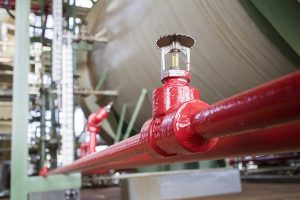
Maintaining your fire sprinkler could save lives!
Automatic sprinkler systems are crucial for protecting your business as they act as the first line of defense against fire, but they only work when properly maintained. When sprinkler systems are not inspected regularly, malfunctions can occur that can cause danger to your building and employees. Sprinkler systems should be checked once a year at the very least, but many companies prefer to inspect the system every month or quarter to be sure it is in good shape.
Weekly or Monthly
Every month the valves and gauges should be inspected. The valves should be in their normal open or closed position, properly sealed, locked or supervised, accessible, free from external leaks, undamaged and labeled appropriately.
The inspection differs if the system is dry or wet. For a wet system, the gauges must be in good condition, and the normal water supply pressure maintained. For a dry system, the gauge on the supply side of the dry pipe valve should indicate a normal water pressure, the gauge on the quick-opening device should be the same pressure as the dry pipe valve, and t the gauges on systems with low air or nitrogen pressure alarms should be inspected. Gauges in dry, pre-action and deluge systems can be inspected as often as once a week, while wet pipe system gauges can be inspected once a month.
Quarterly
Every three months, the water flow alarm and supervisory alarm devices, supervisory signal devices, control valves, pressure reducing valves, relief valves and hydraulic nameplates need to be inspected for damage. Additionally, the water flow alarm should be tested by opening the test connection on a wet pipe system and bypass connection on a dry pipe system, as well as check that the fire department connections are visible and in good condition.
Annually
Once a year, you should have an annual inspection completed by a professional inspection company. The inspection list should include all of the monthly and quarterly items, as well as the hanger/seismic bracing, pipes and fittings, interior dry pipe valves, information signage and spare sprinklers. Also, a main drain water flow test should be conducted to determine if there has been a change in the conditions of the water supplied through the backflow preventer or pressure reducing valve.
Your automatic sprinkler system’s main job is to protect your building and will save lives and money in the event of a fire. According to the NFPA, the average loss per fire in buildings with sprinklers was $2,300, compared to an average loss of $10,300 in buildings without a sprinkler system. Regular, periodic inspection and testing is the best defense against system failure and provides the peace of mind you need to operate your business securely and efficiently.
Fire Prevention and Protection Services from Fireline
Whether you need smoke detectors, fire extinguishers, or an automatic sprinkler system installed at your rental property, Fireline has you covered. We have been protecting people and properties from fire damage since 1947—and our experience shows in our excellent work! We are known for our wonderful customer service, our expertise, and our reliability. For more information on how we can help your residential or commercial property, visit us online or give us a call at (800) 553-3405. For more fire safety tips, be sure to follow us on Facebook, Twitter, LinkedIn, and Google+.
